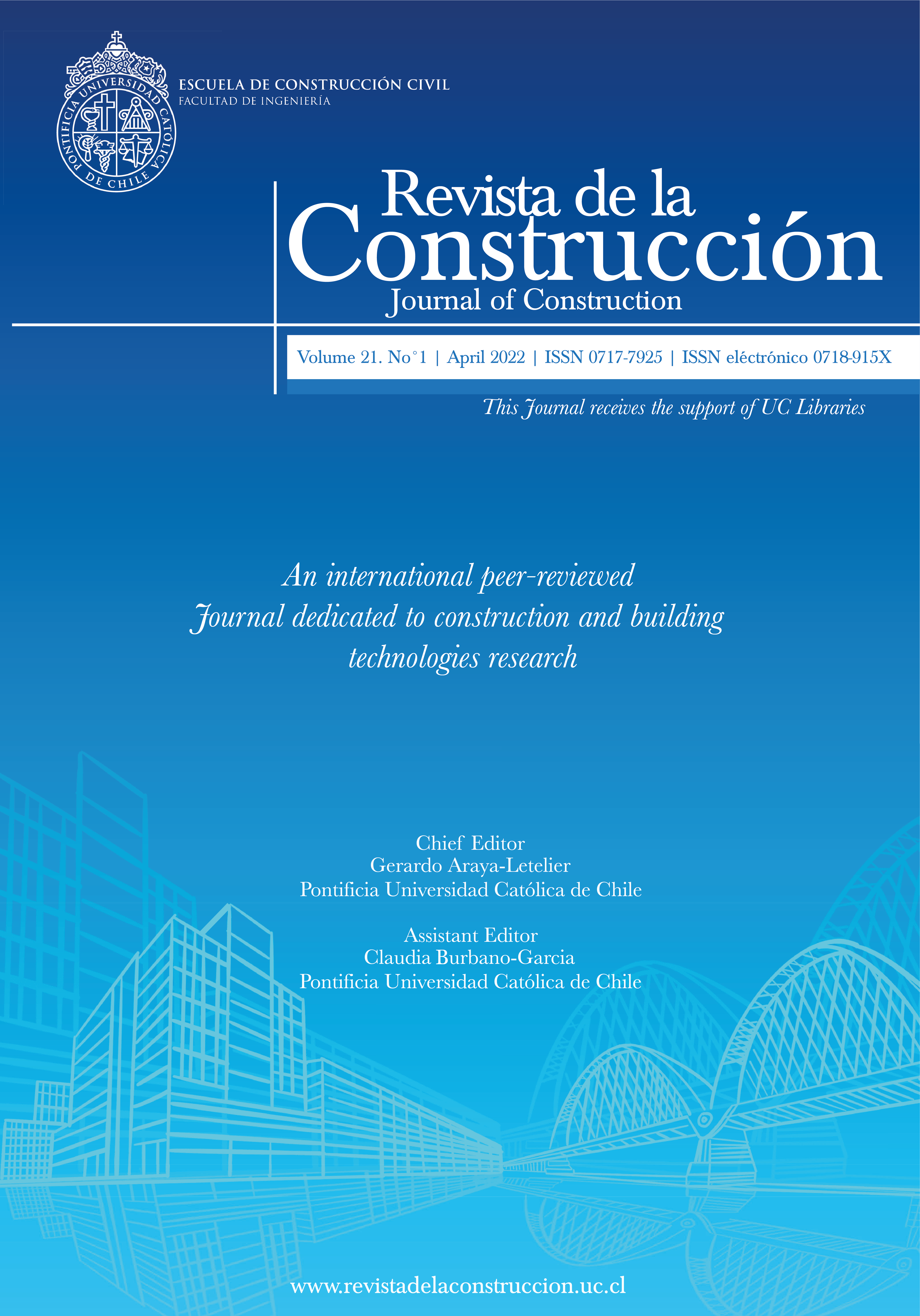Water absorbing polymer balls as internal water curing agent in concrete to support hydration reaction
DOI:
https://doi.org/10.7764/RDLC.21.1.83Keywords:
polymers, air-curing, internal curing, hydration, recycled aggregateAbstract
polymer balls can supply water to the mortar or concrete mixture when added during the initial stage of mixing the concrete ingredients. It supplies the absorbed water during the hydration process of concrete as an internal water source. Water Absorption polymers (WAP) can absorb water up to hundred times of their own weight. Using this idea, the concrete mixture has been prepared with WAP and without WAP (Control) and subjected to air curing and water curing respectively. In this work WAP has been added in two different percentages i.e., 2.5% and 5% of the weight of cement, and the hardened concrete has been subjected to compression load. The mechanical strength and the volumetric change of these mixes were compared with the water cured control mix (Concrete without WAP). From the result, it was concluded that the air-cured specimen showed strength of 30.37 MPa and 28.74 MPa for 2.5% and 5% of addition of WAP balls respectively. This strength is about 99% and 94.2% of the strength of control water-cured specimen. Results also showed that specimens in air behave for expansion while samples in the water acted for shrinkage. Experiment results also showed that air-cured concrete specimens with WAP balls show significant strength gain over a period of 84 days compared to water-cured normal concrete mix samples.
Downloads
References
Afridi, S., Sikandar, M. A., Waseem, M., Nasir, H., & Naseer, A. (2019). Chemical durability of superabsorbent polymer (SAP) based geopol-ymer mortars (GPMs). Construction and Building Materials, 217, 530–542. https://doi.org/10.1016/j.conbuildmat.2019.05.101
Duxson, P., Provis, J. L., Lukey, G. C., & van Deventer, J. S. J. (2007). The role of inorganic polymer technology in the development of “green concrete.” Cement and Concrete Research, 37(12), 1590–1597. https://doi.org/10.1016/j.cemconres.2007.08.018
Esteves, L. P. (2011). Superabsorbent polymers: On their interaction with water and pore fluid. Cement and Concrete Composites, 33(7), 717–724. https://doi.org/10.1016/j.cemconcomp.2011.04.006
Faxiang, X., Dingpeng, C., Lin, J., Chuanlong, Z., Jing, R., & Xiao, L. (2021). Combined compression-shear performance and failure criteria of internally cured concrete with super absorbent polymer. Construction and Building Materials, 266, 120888. https://doi.org/10.1016/j.conbuildmat.2020.120888
HoonKang, S., GulHong, S., & Moon, J. (2017). Absorption Kinetics of superabsorbent polymers(SAP) in various cement based solutions. Cement and Concrete Research, 97, 73–83.
Justs, J., Wyrzykowski, M., Bajare, D., & Lura, P. (2015). Internal curing by superabsorbent polymers in ultra-high performance concrete. Cement and Concrete Research, 76, 82–90. https://doi.org/10.1016/j.cemconres.2015.05.005
Li, Z., Wyrzykowski, M., Dong, H., Granja, J., Azenha, M., Lura, P., & Ye, G. (2020). Internal curing by superabsorbent polymers in alkali-activated slag. Cement and Concrete Research, 135(October), 106123. https://doi.org/10.1016/j.cemconres.2020.106123
Lyu, Z., Shen, A., Mo, S., Chen, Z., He, Z., Li, D., & Qin, X. (2020). Life-cycle crack resistance and micro characteristics of internally cured concrete with superabsorbent polymers. Construction and Building Materials, 259, 119794. https://doi.org/10.1016/j.conbuildmat.2020.119794
Ma, X., Liu, J., Anhui, Wu, Z., & Shi, C. (2017). Effect of SAP on the properties and pore strucutre of high performance cement-based mate-rials. Construction and Building Materials, 131, 476–484.
Meyst, L. De, Mannekens, E., Tittelboom, K. Van, & Belie, N. De. (2021). The influence of superabsorbent polymers (SAPs) on autogenous shrinkage in cement paste, mortar and concrete. Construction and Building Materials, 286(12948), 1–18.
Oh, S., & Choi, Y. C. (2018). Superabsorbent polymers as internal curing agents in alkali activated slag mortars. Construction and Building Materials, 159, 1–8. https://doi.org/10.1016/j.conbuildmat.2017.10.121
Olawuyi, B., Babafemi, A., & Boshoff, W. (2021). Early-age and long-term strenght development of high-performance concrete with SAP. Construction and Building Materials, 267(121798), 1–13.
Olivier, G., Combrinck, R., Kayondo, M., & Boshoff, W. P. (2018). Combined effect of nano silica, super absorbent polymers, and synthetic fibers on plastic shrinkage cracking in concrete. Construction and Building Materials, 192, 85–98.
Riyazi, S., Kevern, J. T., & Mulheron, M. (2017). Super absorbent polymers (SAPs) as physical air entrainment in cement mortars. Construc-tion and Building Materials, 147, 669–676.
Shen, D., Feng, Z., Kang, J., Wen, C., & Shi, H. (2020). Effect of Barchip fiber on stress relaxation and cracking potential of concrete internal-ly cured with super absorbent polymers. Construction and Building Materials, 249, 118392. https://doi.org/10.1016/j.conbuildmat.2020.118392
Shen, D., Liu, C., Jiang, J., Kang, J., & Li, M. (2020). Influence of super absorbent polymers on early-age behavior and tensile creep of inter-nal curing high strength concrete. Construction and Building Materials, 258, 120068. https://doi.org/10.1016/j.conbuildmat.2020.120068
Tanyildizi, H. (2021). Investigation of mechanical properties of polymer impregnated concrete containing polypropylene fiber by taguchi and anova methods. Revista de La Construcción, 20(1), 52–61. https://doi.org/10.7764/rdlc.20.1.52
Tu, W., Zhu, Y., Fang, G., Wang, X., & Zhang, M. (2019). Internal curing of alkali-activated fly ash-slag pastes using superabsorbent poly-mer. Cement and Concrete Research, 116(October 2018), 179–190. https://doi.org/10.1016/j.cemconres.2018.11.018
Xie, F., Cai, D., Ji, L., Zhang, C., & Ruan, J. (2021). Experimental study on the mechanical properties of internally cured concrete with super absorbent polymers under mononic and cyclic loads. Construction and Building Materials, 270(121495), 1–12.
Yang, J., Guo, Y., Shen, A., Chen, Z., Qin, X., & Zhao, M. (2019). Research on drying shrinkage deformation and cracking risk of pavement concrete internally cured by SAPs. Construction and Building Materials, 227, 116705. https://doi.org/10.1016/j.conbuildmat.2019.116705
Yao, Y., Zhu, Y., & Yang, Y. (2012). Incorporation superabsorbent polymer (SAP) particles as controlling pre-existing flaws to improve the performance of engineered cementitious composites (ECC). Construction and Building Materials, 28(1), 139–145. https://doi.org/10.1016/j.conbuildmat.2011.08.032
Downloads
Published
How to Cite
Issue
Section
License
Copyright (c) 2022 Vijayalakshmi Ramalingam, Kamalesh Ramesh, Madhankumar Duraipandi, Jayesh U, Selvam Kuppusamy

This work is licensed under a Creative Commons Attribution-NonCommercial-NoDerivatives 4.0 International License.








